Introduction to Beijing Opera
- 格式:ppt
- 大小:6.94 MB
- 文档页数:29
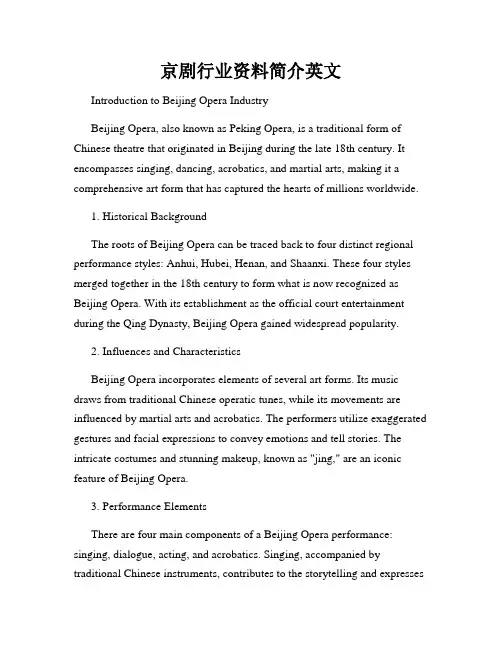
京剧行业资料简介英文Introduction to Beijing Opera IndustryBeijing Opera, also known as Peking Opera, is a traditional form of Chinese theatre that originated in Beijing during the late 18th century. It encompasses singing, dancing, acrobatics, and martial arts, making it a comprehensive art form that has captured the hearts of millions worldwide.1. Historical BackgroundThe roots of Beijing Opera can be traced back to four distinct regional performance styles: Anhui, Hubei, Henan, and Shaanxi. These four styles merged together in the 18th century to form what is now recognized as Beijing Opera. With its establishment as the official court entertainment during the Qing Dynasty, Beijing Opera gained widespread popularity.2. Influences and CharacteristicsBeijing Opera incorporates elements of several art forms. Its music draws from traditional Chinese operatic tunes, while its movements are influenced by martial arts and acrobatics. The performers utilize exaggerated gestures and facial expressions to convey emotions and tell stories. The intricate costumes and stunning makeup, known as "jing," are an iconic feature of Beijing Opera.3. Performance ElementsThere are four main components of a Beijing Opera performance: singing, dialogue, acting, and acrobatics. Singing, accompanied by traditional Chinese instruments, contributes to the storytelling and expressesthe characters' emotions. Dialogue is often delivered in a rhythmic and stylized manner, serving to enhance the dramatic effect. The actors employ specific techniques in their acting to portray the personalities and characteristics of their respective roles. Additionally, acrobatics are incorporated to showcase the performers' agility and skill.4. Famous Roles and StoriesBeijing Opera has a rich repertoire of famous characters and stories, many of which have been performed for centuries. Some well-known roles include Sheng (male role), Dan (female role), Jing (painted-face role), and Chou (clown role). Each role has specific characteristics and symbolism. Popular stories often depict Chinese historical events, legends, or classical literary works, showcasing the traditions, virtues, and cultural heritage of China.5. Challenges and Preservation EffortsIn recent years, Beijing Opera has faced challenges in attracting younger audiences who are more interested in modern forms of entertainment. Additionally, the difficulty of learning the art form and the declining number of skilled performers pose challenges for its preservation. Efforts are being made to promote Beijing Opera through adaptations, modernizations, and educational programs, aiming to bring this traditional art to a broader audience.6. International RecognitionDespite its roots in Chinese culture, Beijing Opera has gained international recognition. It has been performed in numerous countriesworldwide, showcasing Chinese heritage and promoting cultural exchange. Additionally, Beijing Opera has been listed as a UNESCO Intangible Cultural Heritage of Humanity, further highlighting its significance and unique artistic value.ConclusionBeijing Opera holds a significant place in Chinese cultural history. Its blend of singing, acting, dancing, and acrobatics creates a mesmerizing spectacle that continues to captivate audiences around the world. By understanding its historical background, unique characteristics, and current challenges, we can appreciate the importance of preserving and promoting this traditional art form for generations to come.。
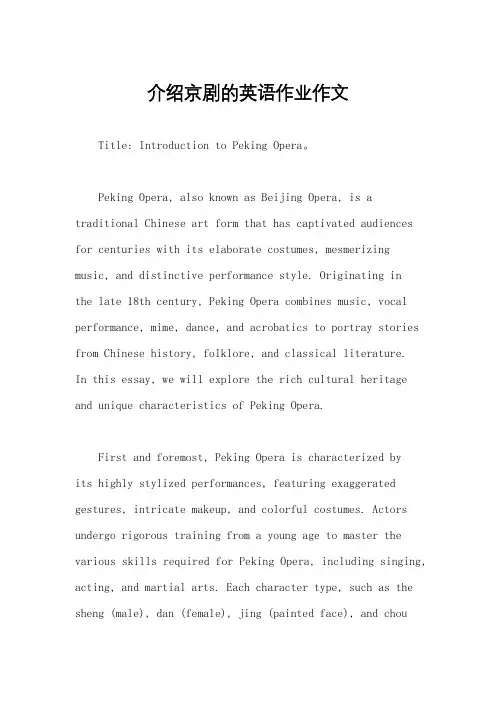
介绍京剧的英语作业作文Title: Introduction to Peking Opera。
Peking Opera, also known as Beijing Opera, is a traditional Chinese art form that has captivated audiences for centuries with its elaborate costumes, mesmerizing music, and distinctive performance style. Originating inthe late 18th century, Peking Opera combines music, vocal performance, mime, dance, and acrobatics to portray stories from Chinese history, folklore, and classical literature.In this essay, we will explore the rich cultural heritage and unique characteristics of Peking Opera.First and foremost, Peking Opera is characterized byits highly stylized performances, featuring exaggerated gestures, intricate makeup, and colorful costumes. Actors undergo rigorous training from a young age to master the various skills required for Peking Opera, including singing, acting, and martial arts. Each character type, such as the sheng (male), dan (female), jing (painted face), and chou(clown), has its own distinct vocal and movement techniques, allowing performers to convey a wide range of emotions and personalities on stage.One of the most striking aspects of Peking Opera is its elaborate makeup, especially the iconic painted faces ofthe jing roles. These intricate designs, often featuring bold colors and intricate patterns, serve to symbolize the characters' personalities and moral traits. For example, a red face may represent bravery and loyalty, while a black face may signify fierceness and determination. The makeup, combined with lavish costumes and accessories, helps to create visually stunning characters that come to life on stage.In addition to its visual spectacle, Peking Opera is renowned for its unique musical style, which combines traditional Chinese instruments such as the erhu, pipa, and gong with operatic singing techniques. The music of Peking Opera serves to enhance the drama and mood of the performance, with melodies ranging from delicate andmelodic to fast-paced and rhythmic. Each character type hasits own distinctive singing style, from the high-pitched trills of the dan roles to the powerful belting of the jing roles.Furthermore, Peking Opera incorporates elements of dance and acrobatics to create dynamic and visually stunning performances. Acrobatic feats such as somersaults, flips, and swordplay are seamlessly integrated into the action, adding excitement and spectacle to the show. Meanwhile, dance movements, inspired by traditional Chinese martial arts and folk dances, help to convey the emotions and narrative of the story.Despite its traditional roots, Peking Opera continues to evolve and adapt to modern times, with contemporary productions incorporating elements of Western theater and technology. However, the essence of Peking Opera remains unchanged, as it continues to celebrate Chinese culture and history through its timeless stories and vibrant performances.In conclusion, Peking Opera is a unique and captivatingart form that showcases the rich cultural heritage of China. With its elaborate costumes, stylized performances, and distinctive music, Peking Opera continues to enchant audiences around the world with its timeless tales of heroism, romance, and adventure. Whether you're a seasoned opera aficionado or a newcomer to the world of Chinese theater, Peking Opera offers a mesmerizing glimpse into the beauty and complexity of traditional Chinese art.。

给外国朋友介绍北京戏剧邮件英语作文全文共3篇示例,供读者参考篇1Introduction to Beijing Drama for Foreign FriendsBeijing, the capital city of China, is not only a political and economic center, but also a cultural hub with a rich history of traditional arts, including the ancient art form of Peking opera. Peking opera, or Beijing opera as it is commonly referred to outside of China, is a traditional Chinese theater that combines music, dance, martial arts, and acrobatics.Peking opera dates back to the late 18th century and has been passed down through generations, becoming one of China's most well-known and cherished cultural treasures. The art form features elaborate costumes, colorful makeup, stylized movements, and distinct vocal styles. Performances often depict historical stories, myths, legends, and moral tales, with characters ranging from warriors and scholars to gods and ghosts.One of the distinguishing features of Peking opera is the combination of singing, speaking, and recitation known as "jinghuang." Performers use a unique vocal technique thatinvolves high-pitched singing and dramatic modulation to convey emotions and narratives. The accompanying music, played on traditional Chinese instruments like the erhu and pipa, adds depth and richness to the performances.In addition to the vocal and musical elements, Peking opera also incorporates elaborate choreography and acrobatic movements. Performers undergo years of rigorous training to master the physical techniques required to execute the intricate dance sequences and martial arts stunts that are integral to the art form.The costumes and makeup in Peking opera are also highly symbolic and play a crucial role in character portrayal. Each color, pattern, and accessory carries specific meanings and conveys the personality, social status, and emotions of the characters. For example, red symbolizes loyalty and courage, while black represents fierceness and determination.Peking opera performances are typically staged in traditional theaters, with ornate sets and intricate props that transport audiences back in time to ancient China. The elaborate costumes, striking makeup, and dynamic performances create a visually stunning and immersive experience that captivates audiences of all ages.In recent years, efforts have been made to preserve and promote Peking opera as a cultural heritage by introducing it to international audiences. The art form has gained popularity abroad, with performances held in major cities around the world and collaborations with foreign artists and theater companies.For foreign friends visiting Beijing, watching a Peking opera performance is a unique and enriching cultural experience that provides insight into the traditions and artistry of Chinese theater. Whether you are a theater enthusiast or simply curious about Chinese culture, attending a Peking opera show is sure to leave a lasting impression and deepen your appreciation for the beauty and complexity of this ancient art form.In conclusion, Beijing drama is an integral part of China's cultural heritage and a window into the country's rich history and artistic traditions. By immersing yourself in the world of Peking opera, you can gain a deeper understanding of Chinese culture and experience the magic of this unique and captivating art form. So, don't miss the opportunity to explore the beauty and allure of Beijing drama during your visit to the capital city of China!篇2Introduction to Beijing OperaAs one of the most traditional and quintessential forms of Chinese performing arts, Beijing Opera, also known as Peking opera, has a long history dating back to the Qing Dynasty. With its unique combination of music, singing, dance, and acrobatics, Beijing Opera has become a cultural treasure that showcases the rich heritage and artistic achievements of the Chinese people.The Beijing Opera features four main performance elements, including singing, recitation, acting, and acrobatics, each of which plays a crucial role in conveying the rich emotions and storytelling of the performance. The performers, often dressed in elaborate costumes and wearing colorful masks, create dazzling, larger-than-life characters that represent different archetypes and themes.One of the distinctive features of Beijing Opera is its use of symbolic movements and gestures, known as "manner movements," which are used to convey specific emotions, actions, and intentions to the audience. These movements, which are both highly stylized and aesthetically pleasing, add an extra layer of depth and meaning to the performance.The music of Beijing Opera is also an integral part of the experience, with traditional Chinese instruments such as the erhu (a two-stringed fiddle) and the gong (a large drum) providingthe musical accompaniment to the actors' performances. The singing, which is a unique form of stylized chanting known as "jinghuang," is another essential component of Beijing Opera, adding to the overall atmosphere and emotional depth of the performance.In recent years, Beijing Opera has gained popularity not only in China but also in other countries around the world. Its unique blend of music, dance, and storytelling has captivated audiences of all ages and backgrounds, making it a truly universal art form that transcends cultural boundaries.In conclusion, Beijing Opera is a vibrant and dynamic art form that continues to thrive and evolve in today's fast-paced world. Whether you are a seasoned theater-goer or a newcomer to the world of Chinese performing arts, Beijing Opera offers a rich and rewarding experience that is sure to leave a lasting impression. So why not come and experience the magic of Beijing Opera for yourself?篇3Introduction to Beijing Opera for Foreign FriendsBeijing Opera, also known as Peking Opera, is a traditional Chinese performing art that combines music, singing, dialogue,acrobatics, and martial arts. It dates back to the late 18th century and has evolved over the years to become one of the most famous cultural elements of China. It is characterized by its elaborate costumes, colorful makeup, and stylized movements.In a traditional Beijing Opera performance, you will see performers wearing brightly colored costumes and elaborate makeup. The actors use different facial expressions and gestures to convey emotions and character traits. The singing is in a high-pitched, nasal tone, and the music is accompanied by traditional Chinese instruments such as the erhu, pipa, and drums.The stories in Beijing Opera are usually based on Chinese history, legends, or folklore. The performances often include themes of loyalty, betrayal, love, and revenge. The actors use a combination of singing, speaking, and movement to tell the story, and the audience is expected to appreciate the subtle nuances of the performance.One of the most important elements of Beijing Opera is the acrobatics and martial arts. Performers showcase their skills in gymnastics, stunts, and fight scenes to add excitement and drama to the performance. The choreography is intricate and requires years of training to master.If you are interested in experiencing Beijing Opera, there are many theaters in Beijing where you can watch live performances. The most famous theaters include the Liyuan Theater, the Huguang Guild Hall, and the Chang'an Theater. You can also find performances in other major cities in China, as Beijing Opera has become popular worldwide.In conclusion, Beijing Opera is a unique cultural art form that offers a glimpse into the rich history and traditions of China. Its combination of music, singing, acrobatics, and martial arts makes it a captivating and entertaining experience for audiences of all ages. I hope this introduction has piqued your interest in exploring the world of Beijing Opera and experiencing its magic firsthand.。
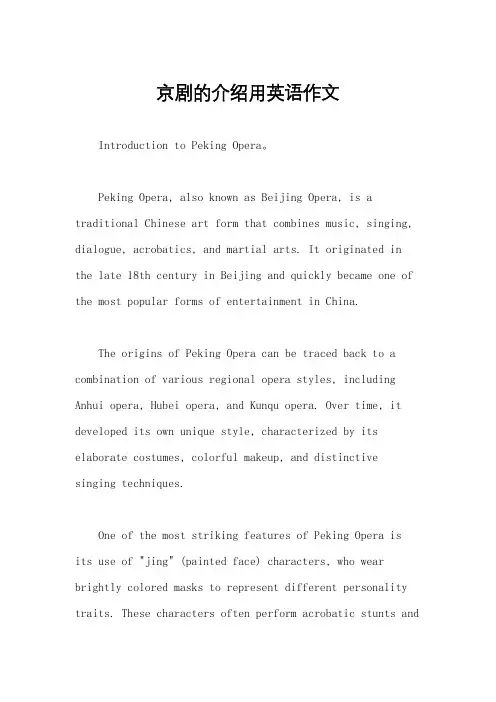
京剧的介绍用英语作文Introduction to Peking Opera。
Peking Opera, also known as Beijing Opera, is a traditional Chinese art form that combines music, singing, dialogue, acrobatics, and martial arts. It originated in the late 18th century in Beijing and quickly became one of the most popular forms of entertainment in China.The origins of Peking Opera can be traced back to a combination of various regional opera styles, including Anhui opera, Hubei opera, and Kunqu opera. Over time, it developed its own unique style, characterized by its elaborate costumes, colorful makeup, and distinctive singing techniques.One of the most striking features of Peking Opera isits use of "jing" (painted face) characters, who wear brightly colored masks to represent different personality traits. These characters often perform acrobatic stunts andfight scenes, adding excitement and drama to the performance.Peking Opera performances typically revolve around historical or mythical stories, with themes of loyalty, love, and justice. The actors use a combination of singing, speaking, and gestures to convey emotions and tell thestory to the audience.In addition to the performers, Peking Opera alsofeatures a live orchestra that accompanies the actors with traditional Chinese instruments such as the erhu (two-stringed fiddle) and the gong (percussion instrument). The music adds depth and emotion to the performance, enhancing the overall experience for the audience.Today, Peking Opera continues to be a popular form of entertainment in China, with performances held in theaters and opera houses across the country. It has also gained international recognition, with troupes touring around the world to showcase this unique art form to a global audience.In conclusion, Peking Opera is a rich and vibrant art form that has captivated audiences for centuries with its colorful costumes, dynamic performances, and timeless stories. It is a cultural treasure that reflects the beauty and diversity of Chinese traditional arts.。
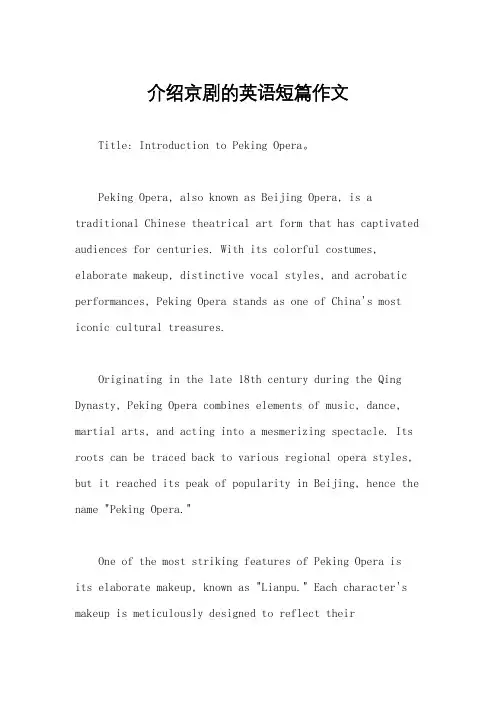
介绍京剧的英语短篇作文Title: Introduction to Peking Opera。
Peking Opera, also known as Beijing Opera, is a traditional Chinese theatrical art form that has captivated audiences for centuries. With its colorful costumes, elaborate makeup, distinctive vocal styles, and acrobatic performances, Peking Opera stands as one of China's most iconic cultural treasures.Originating in the late 18th century during the Qing Dynasty, Peking Opera combines elements of music, dance, martial arts, and acting into a mesmerizing spectacle. Its roots can be traced back to various regional opera styles, but it reached its peak of popularity in Beijing, hence the name "Peking Opera."One of the most striking features of Peking Opera isits elaborate makeup, known as "Lianpu." Each character's makeup is meticulously designed to reflect theirpersonality, social status, and even their emotional state. For example, characters with white faces symbolize treachery and cunning, while red faces represent loyalty and courage.In addition to makeup, Peking Opera is renowned for its intricate costumes, which are adorned with vibrant colors and intricate patterns. These costumes help distinguish the different characters and add to the visual splendor of the performance.Another essential aspect of Peking Opera is its unique vocal style, characterized by a combination of singing, speech, and recitation. Performers use distinct vocal techniques to convey emotions and express the nuances of their characters. The music accompanying the opera often features traditional Chinese instruments such as the erhu, pipa, and bamboo flute, creating a rich and immersive auditory experience.Furthermore, Peking Opera incorporates elements of martial arts, known as "Wusheng," into its performances.Actors undergo rigorous training to master the acrobatic movements and combat sequences required for these roles.The combination of martial arts and theatrical performance adds excitement and dynamism to the opera.Peking Opera typically features a repertoire of classic stories and legends from Chinese history and mythology. These stories often revolve around themes of loyalty, honor, and heroism, resonating with audiences across generations.In recent years, efforts have been made to preserve and promote Peking Opera as an intangible cultural heritage. Institutions and academies dedicated to training new generations of performers have emerged, ensuring that this ancient art form continues to thrive in the modern era.In conclusion, Peking Opera is a vibrant andmultifaceted art form that showcases the rich cultural heritage of China. With its dazzling costumes, captivating performances, and timeless stories, Peking Opera continuesto enchant audiences around the world, embodying the enduring spirit of Chinese culture.。
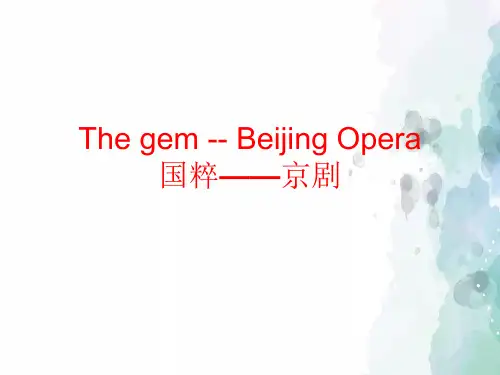
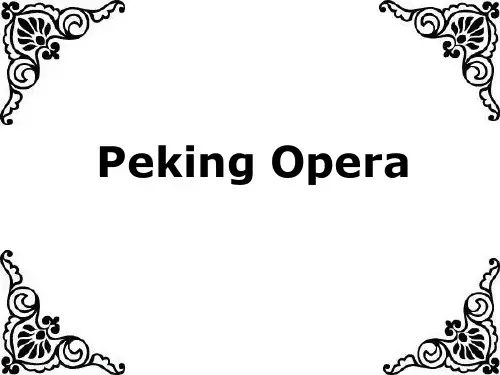
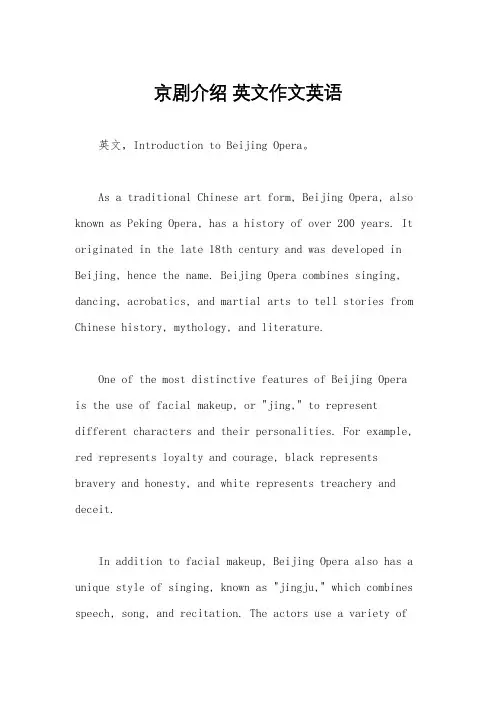
京剧介绍英文作文英语英文,Introduction to Beijing Opera。
As a traditional Chinese art form, Beijing Opera, also known as Peking Opera, has a history of over 200 years. It originated in the late 18th century and was developed in Beijing, hence the name. Beijing Opera combines singing, dancing, acrobatics, and martial arts to tell stories from Chinese history, mythology, and literature.One of the most distinctive features of Beijing Opera is the use of facial makeup, or "jing," to represent different characters and their personalities. For example, red represents loyalty and courage, black represents bravery and honesty, and white represents treachery and deceit.In addition to facial makeup, Beijing Opera also has a unique style of singing, known as "jingju," which combines speech, song, and recitation. The actors use a variety ofvocal techniques, such as falsetto, vibrato, and trills, to express different emotions and moods.Another important aspect of Beijing Opera is the elaborate costumes and props. The costumes are designed to reflect the character's social status, personality, androle in the story. The props, such as swords, fans, and handkerchiefs, are used to enhance the movements and gestures of the actors.Overall, Beijing Opera is a complex and fascinating art form that requires years of training and practice to master. It is a symbol of Chinese culture and heritage, and continues to be popular both in China and around the world.中文,京剧介绍。
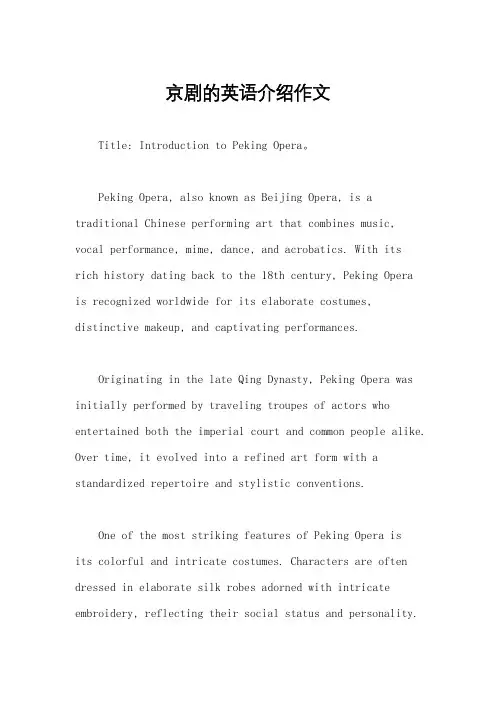
京剧的英语介绍作文Title: Introduction to Peking Opera。
Peking Opera, also known as Beijing Opera, is a traditional Chinese performing art that combines music, vocal performance, mime, dance, and acrobatics. With itsrich history dating back to the 18th century, Peking Operais recognized worldwide for its elaborate costumes, distinctive makeup, and captivating performances.Originating in the late Qing Dynasty, Peking Opera was initially performed by traveling troupes of actors who entertained both the imperial court and common people alike. Over time, it evolved into a refined art form with a standardized repertoire and stylistic conventions.One of the most striking features of Peking Opera isits colorful and intricate costumes. Characters are often dressed in elaborate silk robes adorned with intricate embroidery, reflecting their social status and personality.Moreover, each character's costume is carefully designed to convey specific traits and emotions, enhancing the overall theatrical experience.Another hallmark of Peking Opera is its unique makeup, known as "jing." Actors use a combination of elaboratefacial painting and symbolic colors to represent different character archetypes such as heroes, villains, or supernatural beings. The makeup not only serves as a visual aid for the audience but also helps the actors convey emotions and personalities more effectively.In addition to costumes and makeup, Peking Opera is renowned for its distinctive vocal style and musical accompaniment. The singing in Peking Opera is characterized by its high-pitched, melodious tunes and intricate vocal techniques. Accompanied by traditional Chinese instruments such as the erhu (two-stringed fiddle) and the Chinese lute, the music enhances the dramatic tension and emotional depth of the performances.Furthermore, Peking Opera incorporates elements ofacrobatics and martial arts, adding a dynamic and energetic dimension to the performances. Actors showcase impressive feats of agility and strength, including somersaults, swordplay, and other acrobatic stunts, which captivate audiences and contribute to the spectacle of the art form.Peking Opera performances typically revolve around timeless themes of love, loyalty, honor, and duty, often drawn from Chinese history, mythology, or classic literature. The plots are filled with dramatic twists and turns, accompanied by elaborate choreography and expressive gestures, creating a mesmerizing visual and auditory experience for spectators.In recent years, efforts have been made to preserve and promote Peking Opera as a cultural heritage of China. Institutions and schools dedicated to training young performers have emerged, ensuring that this traditional art form continues to thrive and evolve for future generations to appreciate.In conclusion, Peking Opera is a cherished culturaltreasure that embodies the rich heritage and artistic traditions of China. Through its elaborate costumes, distinctive makeup, expressive singing, and dynamic performances, Peking Opera continues to enchant audiences around the world with its timeless stories and captivating artistry.。
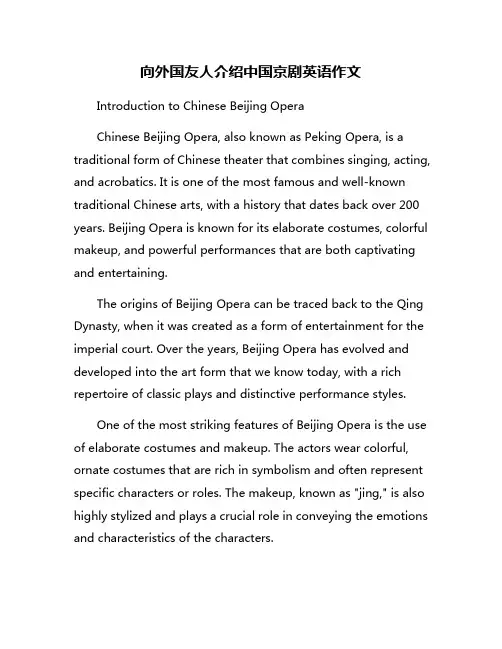
向外国友人介绍中国京剧英语作文Introduction to Chinese Beijing OperaChinese Beijing Opera, also known as Peking Opera, is a traditional form of Chinese theater that combines singing, acting, and acrobatics. It is one of the most famous and well-known traditional Chinese arts, with a history that dates back over 200 years. Beijing Opera is known for its elaborate costumes, colorful makeup, and powerful performances that are both captivating and entertaining.The origins of Beijing Opera can be traced back to the Qing Dynasty, when it was created as a form of entertainment for the imperial court. Over the years, Beijing Opera has evolved and developed into the art form that we know today, with a rich repertoire of classic plays and distinctive performance styles.One of the most striking features of Beijing Opera is the use of elaborate costumes and makeup. The actors wear colorful, ornate costumes that are rich in symbolism and often represent specific characters or roles. The makeup, known as "jing," is also highly stylized and plays a crucial role in conveying the emotions and characteristics of the characters.In addition to the costumes and makeup, Beijing Opera is also known for its unique performance style. The actors use a combination of singing, speaking, and gestures to convey the emotions and actions of the characters. The performances are highly stylized and often include acrobatic movements and martial arts techniques.The stories in Beijing Opera are usually based on historical events, legends, or traditional Chinese literature. The plays often feature themes of loyalty, honor, and sacrifice, and the characters are typically heroic figures who overcome great challenges and adversity.In recent years, Beijing Opera has gained popularity both in China and around the world. Many international audiences have been captivated by the beauty and intensity of Beijing Opera performances, and there are now many theaters and festivals dedicated to showcasing this traditional art form.In conclusion, Chinese Beijing Opera is a unique and vibrant form of traditional Chinese theater that continues to captivate audiences with its colorful costumes, elaborate makeup, and powerful performances. Whether you are a fan of theater, music, or dance, Beijing Opera is sure to leave a lasting impression and provide a memorable cultural experience.。
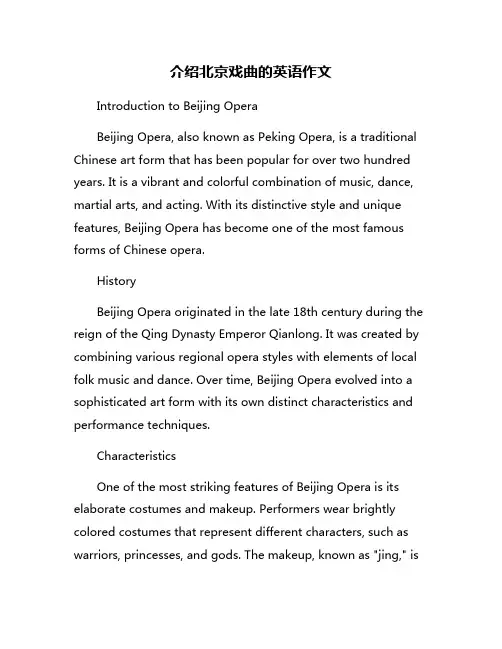
介绍北京戏曲的英语作文Introduction to Beijing OperaBeijing Opera, also known as Peking Opera, is a traditional Chinese art form that has been popular for over two hundred years. It is a vibrant and colorful combination of music, dance, martial arts, and acting. With its distinctive style and unique features, Beijing Opera has become one of the most famous forms of Chinese opera.HistoryBeijing Opera originated in the late 18th century during the reign of the Qing Dynasty Emperor Qianlong. It was created by combining various regional opera styles with elements of local folk music and dance. Over time, Beijing Opera evolved into a sophisticated art form with its own distinct characteristics and performance techniques.CharacteristicsOne of the most striking features of Beijing Opera is its elaborate costumes and makeup. Performers wear brightly colored costumes that represent different characters, such as warriors, princesses, and gods. The makeup, known as "jing," iscarefully applied to create exaggerated facial expressions that convey the emotions and personalities of the characters.Another important aspect of Beijing Opera is its use of traditional Chinese musical instruments, such as the erhu (atwo-stringed fiddle) and the pipa (a pear-shaped lute). The music is accompanied by percussion instruments, such as drums and gongs, which help to create a dynamic and rhythmic sound.PerformanceBeijing Opera performances are a spectacle of sight and sound, with performers showcasing their skills in singing, acting, and acrobatics. The actors use a combination of gestures, movements, and facial expressions to convey the emotions and actions of the characters. The performers also engage in martial arts sequences, known as "fighting scenes," which showcase their agility and strength.Audiences are captivated by the dramatic storytelling, colorful costumes, and high-energy performances of Beijing Opera. The traditional stories often revolve around themes of loyalty, honor, and sacrifice, making them both entertaining and thought-provoking.LegacyBeijing Opera has had a lasting impact on Chinese culture and has influenced other forms of art, such as Chinese cinema and theater. It has also gained international recognition and has been performed in countries around the world. Despite the challenges of modernization and changing tastes, Beijing Opera continues to thrive as a cherished cultural heritage of China.In conclusion, Beijing Opera is a captivating art form that showcases the rich traditions and history of Chinese culture. With its vibrant costumes, dynamic performances, and timeless stories, it continues to enchant audiences and inspire artists around the world.。
介绍北京戏曲英语作文简短标题,Introduction to Beijing Opera。
Beijing Opera, also known as Peking Opera, is a traditional Chinese theatrical art form that originated in the late 18th century in Beijing. It is widely regarded as one of the most representative forms of Chinese culture, blending music, vocal performance, mime, dance, and acrobatics into a cohesive and vibrant theatrical experience.The origins of Beijing Opera can be traced back to the Qing Dynasty, when it emerged as a synthesis of various regional performance styles, including Kunqu, Hanju, and local folk traditions. Over time, it evolved into adistinct art form with its own unique characteristics and repertoire.One of the defining features of Beijing Opera is its elaborate makeup and costumes, which are designed to conveythe personalities and emotions of the characters. The performers, known as "dan" (female roles), "sheng" (male roles), "jing" (painted face roles), and "chou" (clown roles), undergo years of rigorous training to master the intricate movements and vocal techniques required for their respective roles.The music of Beijing Opera is equally distinctive, characterized by its use of traditional Chinese instruments such as the erhu, pipa, and bamboo flute. The melodies are often based on traditional Chinese folk tunes and are used to convey the mood and atmosphere of the performance.In addition to its musical and visual elements, Beijing Opera is also known for its rich repertoire of stories, which draw upon a wide range of historical events, legends, and folktales. These stories often explore themes of loyalty, honor, and love, and are performed with a combination of spoken dialogue, singing, and stylized movement.Despite its long history and cultural significance,Beijing Opera has faced challenges in recent years, particularly as younger audiences gravitate towards modern forms of entertainment. However, efforts are being made to preserve and promote this ancient art form, withinitiatives such as educational programs, international tours, and collaborations with contemporary artists.In conclusion, Beijing Opera is a unique and vibrant art form that continues to captivate audiences with its colorful costumes, melodious music, and timeless stories. By preserving and celebrating this rich cultural heritage, we can ensure that future generations will continue to appreciate the beauty and artistry of Beijing Opera.。
介绍京剧是什么时候开始的用英语作文全文共3篇示例,供读者参考篇1Introduction to Peking OperaPeking Opera, also known as Beijing Opera, is a traditional Chinese form of opera that combines music, vocal performance, mime, dance, and acrobatics. It is one of the oldest and most prestigious forms of Chinese opera and has a history that dates back over 200 years.Peking Opera originated in the late 18th century during the Qing Dynasty, when four major opera troupes from different regions of China were invited to perform in Beijing to celebrate the birthday of the Qianlong Emperor. These troupes combined various regional styles of opera, music, and performance techniques to create a new and unique form of opera that would later become known as Peking Opera.The early years of Peking Opera were characterized by influences from other forms of Chinese opera, such as Kunqu and Sichuan opera, as well as traditional Chinese music and dance. However, Peking Opera soon developed its owndistinctive style, with elaborate costumes, makeup, and choreography that set it apart from other forms of opera.Peking Opera became popular among the common people in Beijing and throughout China, and it soon became a staple of Chinese cultural life. It was performed in teahouses, theaters, and even in the streets, and it became a favorite pastime for people of all ages.In the early 20th century, Peking Opera underwent a period of decline due to the influence of Western culture and the rise of other forms of entertainment. However, in recent years, there has been a renewed interest in Peking Opera, both in China and around the world. Efforts have been made to preserve and promote this traditional art form, and Peking Opera has regained its status as a cultural treasure of China.Today, Peking Opera continues to be performed in theaters and opera houses in China and in other countries, and it remains a vibrant and colorful form of entertainment that showcases the rich cultural heritage of China. Its elaborate costumes, stylized movements, and unique blend of music and performance continue to captivate audiences and make Peking Opera a beloved and enduring art form.篇2The Origins and Development of Peking OperaPeking Opera, also known as Beijing Opera, is a traditional form of Chinese theatre that combines music, singing, dialogue, and acrobatics. It is one of the most famous and influential forms of Chinese opera and has a history that dates back over 200 years.The origins of Peking Opera can be traced back to the early 19th century during the Qing Dynasty. It was initially created as a form of entertainment for the imperial court and gradually evolved to become a popular form of entertainment for the common people. Peking Opera is known for its elaborate costumes, intricate makeup, and stylized movements, as well as its use of martial arts and acrobatics to enhance the performance.One of the key features of Peking Opera is the use of four main character types: sheng (male roles), dan (female roles), jing (painted face roles), and chou (clown roles). Each character type has its own specific movements, gestures, and vocalizations, which are used to convey emotions and tell the story.Peking Opera has a rich repertoire of over 1,400 plays, which cover a wide range of topics including historical events, legends, and myths. Some of the most famous Peking Opera plays include "The Legend of the White Snake," "The Peach Blossom Fan," and "Farewell My Concubine."Over the years, Peking Opera has spread beyond China and has gained international recognition as a unique and vibrant art form. It has inspired artists and performers around the world and continues to be a popular form of entertainment in China and beyond.In conclusion, Peking Opera is a cultural treasure that has a long and storied history. Its unique blend of music, singing, and acrobatics has captivated audiences for centuries and will continue to do so for many years to come.篇3Beijing Opera, also known as Peking Opera, is a traditional Chinese form of drama that combines singing, dancing, and acrobatics. It originated in the late 18th century during the Qing Dynasty and has since become one of the most popular forms of Chinese opera.The history of Beijing Opera can be traced back to the reign of Emperor Qianlong in the late 18th century. It was during this time that a group of opera performers from Anhui Province came to Beijing to perform for the emperor. These performers brought with them their own style of opera, which became known as Anhui Opera. Over time, this style of opera merged with local Beijing drama, resulting in the creation of Beijing Opera.Beijing Opera quickly gained popularity among the Chinese elite, and it soon became a staple of imperial court entertainment. The art form continued to evolve over the years, with new techniques and styles being incorporated into the performances. By the early 20th century, Beijing Opera had become a well-established form of entertainment that was beloved by people all over China.One of the key features of Beijing Opera is its distinctive singing style, known as "jinghuang." This style involves performers singing in a high-pitched voice while using various vocal techniques to convey different emotions. In addition to singing, Beijing Opera also includes elaborate costumes, colorful makeup, and acrobatic movements that add to the visual spectacle of the performances.Today, Beijing Opera is considered a national treasure in China and is recognized as an intangible cultural heritage by UNESCO. It continues to be performed in theaters all over the country, attracting both domestic and international audiences. Beijing Opera has also influenced other forms of Chinese opera, such as Cantonese opera and Sichuan opera, demonstrating its lasting impact on Chinese culture.In conclusion, Beijing Opera is a unique and captivating art form that has been cherished by the Chinese people for centuries. Its rich history and colorful performances have made it a beloved cultural institution that continues to thrive to this day.。
关于北京歌剧的英语作文高分英语作文l:Introduction to Beijing OperaBeijing Opera is being introduced to primary and secondary school students to promote traditional art to the younger generation.Among the first set of Peking Opera textbooks jointly compiled and published by the Beijing quintessence PromotionAssociationandthepeople'seducation press,optional course materials have been put on trialinFengtai District junior high schools and will be officially put intouseafewdaysago.Primary school textbooks will also be launched in secondary schools throughout the city,because Beijing is already in the Dozens of primary schools have launched a program to provide opera training.During the Qianlong reign of the Qing Dynasty,it flourished in China for decades.With the spread of its fame,it attracted audiences from other countries,including the United States and Japan.However,over the years,its popularitydeclined,and quite a number of people listened to Peking Opera before the s Works,generations born after that pursue popular culture rather than traditional art.中文翻译:京剧正在向中小学生介绍,向年轻一代推广传统艺术,据《新京报》上周二报道,由北京市国粹促进会和人民教育出版社联合编制出版的全国首套京剧教材中,选修课教材已在丰台区初中试行,并将于日前正式启用在全市中学使用小学课本也将推出,因为北京已在数十所小学推行了一个提供歌剧培训的项目。
英文介绍京剧作文范文简短Title: Introduction to Peking Opera。
Peking Opera, also known as Beijing Opera, is a traditional Chinese art form that combines music, vocal performance, mime, dance, and acrobatics. It originated in the late 18th century in Beijing and has since become one of the most well-known Chinese cultural treasures. Here's a brief introduction to this captivating art form:Origin and History:Peking Opera emerged during the Qing Dynasty, blending various regional performance styles prevalent at the time, including Kunqu, Qinqiang, and Bangzi. It was initially performed for the imperial court and later gainedpopularity among the general public. Over the centuries, it has evolved and incorporated elements from folk traditions, literature, and historical events.Distinctive Features:One of the most striking features of Peking Opera isits elaborate makeup and costumes. Actors wear colorful, intricate costumes and apply symbolic facial makeup, known as "jing," to represent different character types, such as warriors, scholars, or villains. Each color and pattern carries specific meanings, allowing the audience toidentify the characters at a glance.Another essential aspect of Peking Opera is its unique vocal style. Performers use a combination of singing, recitation, and speech to convey emotions and dialogue. The vocal techniques are highly stylized, with distinct melodies and rhythms for different character roles. Accompanying the vocals is a traditional Chinese orchestra, consisting of instruments like the bamboo flute, drum, and stringed instruments like the erhu and pipa.Themes and Stories:Peking Opera draws inspiration from Chinese history,mythology, and classic literature. Its repertoire includes a wide range of stories, from epic tales of heroism and romance to moralistic fables and historical dramas. Many of these stories are based on famous novels like "The Romance of the Three Kingdoms" and "Journey to the West," as well as historical events such as the fall of dynasties or famous battles.Performance Techniques:Actors in Peking Opera undergo rigorous training from a young age to master various performance techniques. These include not only singing and acting but also acrobatics, martial arts, and dance. Movements are highly stylized and symbolic, with each gesture carrying specific meanings. Performers must also learn the art of "jingju," or role types, which define their characters' personalities and traits.Regional Variations:While Peking Opera originated in Beijing, it has spreadto other regions of China, leading to the development of regional variations. Each variation retains the essential elements of Peking Opera but incorporates local dialects, musical styles, and performance techniques. Some notable regional styles include Shanghai Opera, Tianjin Opera, and Cantonese Opera.Cultural Significance:Peking Opera plays a vital role in Chinese culture, serving as a bridge between the past and the present. It reflects the values, beliefs, and aesthetics of traditional Chinese society while also adapting to modern sensibilities. Despite facing challenges from changing tastes and technological advancements, it continues to thrive as a cherished cultural heritage, captivating audiences both in China and around the world.In conclusion, Peking Opera is a mesmerizing art form that showcases the rich cultural heritage of China. Withits elaborate costumes, distinctive makeup, and dynamic performances, it offers a window into the country's history,mythology, and artistic traditions. Whether you're a seasoned aficionado or a newcomer to Chinese culture, experiencing Peking Opera is an unforgettable journey into the heart of China's artistic soul.。
英语作文京剧的介绍Introduction to Beijing Opera。
Beijing Opera, also known as Peking Opera, is a traditional Chinese art form that has been around for over 200 years. It is considered the quintessence of Chinese culture, with its unique blend of music, dance, acrobatics, and martial arts.Beijing Opera originated in the late 18th century, during the reign of Emperor Qianlong of the Qing Dynasty. It was created by a group of actors who combined elements of various regional opera styles to form a new, distinctart form. Over time, Beijing Opera became popular throughout China and eventually spread to other parts of the world.The four main elements of Beijing Opera are singing, acting, dancing, and acrobatics. The singing is done in a high-pitched, nasal style known as "jinghuang," which isaccompanied by traditional instruments such as the erhu, pipa, and suona. The acting is highly stylized, with performers using exaggerated facial expressions and body movements to convey emotions and tell stories. The dancing is also very stylized, with performers using intricate footwork and gestures to express themselves. Finally, the acrobatics involve feats of strength and agility, such as tumbling, balancing, and sword fighting.Beijing Opera is known for its colorful costumes and makeup. Each character has a specific look, with different colors and designs representing their personality and role in the story. The makeup is also highly stylized, with performers using different colors and patterns to create specific facial expressions and emotions.One of the most famous Beijing Opera stories is "The Legend of the White Snake," which tells the story of a snake spirit who falls in love with a human and must overcome many obstacles to be with him. Another popular story is "Farewell My Concubine," which tells the story of a famous general who falls in love with his concubine andmust choose between his love for her and his duty to his country.In recent years, Beijing Opera has faced challenges as younger generations show less interest in the traditional art form. However, efforts are being made to preserve and promote Beijing Opera, including the establishment of schools and training programs for young performers.In conclusion, Beijing Opera is a unique and fascinating art form that has played an important role in Chinese culture for over 200 years. Its blend of music, dance, acrobatics, and storytelling continues to captivate audiences around the world.。
京剧的介绍英语作文Title: Introduction to Peking Opera。
Peking Opera, also known as Beijing Opera, is a traditional Chinese theatrical art form that has captivated audiences for centuries. Renowned for its elaborate costumes, stylized movements, and powerful vocal performances, Peking Opera represents the pinnacle of Chinese cultural heritage. In this essay, we will delveinto the rich history, distinctive features, and enduring significance of this remarkable art form.Historical Background:Peking Opera traces its origins back to the late 18th century during the Qing Dynasty. It emerged as a synthesis of various regional performance styles, including Kunqu opera, Beijing local operas, and forms of Chinese music and dance. Initially performed in teahouses and marketplaces, Peking Opera gradually gained popularity among the urbanpopulation and became a prominent form of entertainment during the Qing Dynasty.Distinctive Features:One of the defining characteristics of Peking Opera is its emphasis on symbolism and stylized movements.Performers utilize a wide range of gestures, postures, and facial expressions to convey emotions and depict characters. Movements are highly choreographed and symbolic, with each gesture carrying specific meanings. For example, thelifting of a sleeve or the flick of a fan can signify different actions or emotions.Another notable feature of Peking Opera is itselaborate costumes and makeup. Actors wear intricate costumes that represent various historical figures,mythical characters, or archetypes. Makeup, known as "jing," plays a crucial role in defining characters and conveying their personalities. Different colors andpatterns are used to denote specific traits such as loyalty, courage, or villainy.Performance Elements:Peking Opera combines several artistic elements, including singing, acting, martial arts, and acrobatics.The vocal performances, characterized by high-pitchedsinging and melodic recitation, are accompanied bytraditional Chinese instruments such as the erhu, pipa, and bamboo flute. Actors also demonstrate impressive martialarts skills, executing intricate fight scenes withprecision and agility.Moreover, Peking Opera incorporates elements of symbolism and metaphor in its storytelling. Themes often revolve around historical events, legends, or moral lessons, reflecting traditional Chinese values and beliefs. Through vivid storytelling and dynamic performances, Peking Opera serves as a vehicle for cultural transmission and artistic expression.Enduring Significance:Despite modernization and changing cultural tastes, Peking Opera continues to thrive as a cherished cultural heritage of China. It has garnered international recognition for its artistic merit and cultural significance, earning UNESCO's designation as an Intangible Cultural Heritage of Humanity in 2010. Efforts are underway to preserve and promote Peking Opera, ensuring that future generations can appreciate its beauty and legacy.In conclusion, Peking Opera stands as a testament to the richness and diversity of Chinese cultural traditions. With its elaborate costumes, stylized movements, and powerful performances, it embodies the essence of Chinese aesthetics and storytelling. As we continue to explore and appreciate the world of Peking Opera, we gain a deeper understanding of China's rich cultural heritage andartistic achievements.。